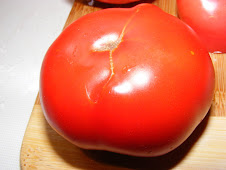First, let me say that I realize my posts have gone off track a bit. Spiders and ladybugs may be helpful and even interesting companions in the garden, but what do they have to do with tomatoes? So on to planting.
I had decided that I would finish planting in the raised beds yesterday, but life got in the way. Now I really wish I had, because today is a miserable day for it, cold and rainy, and no one likes to garden or be planted in this kind of weather. But if I want to follow the moon phases (kind of an experiment this year) I have to get them in today - Full Moon tonight, or wait until after June 3rd, which is the next New Moon. What to do...?! Both, of course!
The flats that have been living in the row tunnels will have to be moved to a green house shelf to make room for the plantees, and that way I will still have plenty of back ups in case they aren't happy being planted out in the raised beds just yet. I'll keep the row tunnel covers on for wet, cold days like this morning, and remove the plastic when it gets too warm, which is what I've been doing for the flats anyway. Hopefully it will warm up a bit today, and the rain will ease off.
I am growing some Santalina's as an experiment this summer. They are a small cherry tomato from the supermarket, that taste pretty good, so I decided to grow them out just for kicks. They have been planted for a couple weeks now. I've made them my test bunnies for different planting methods and fertilizers as well. The first three were planted with a handful of epsom salt and a trowel full of my kitchen compost in the planting hole. The next three got nothing, poor things. One of them even had the stem snapped but not completely broken - thanks to an eager helper.
So far the difference is absolutely amazing. The first three are a good size, and much larger than the last three, as well as much greener and healthier looking. The last three look okay, but very purple. The color could be a result of a magnesium deficiency in my soil, or in the plants' inability to access the nutrients. The second is usually a result of colder temperatures, which has not really been the case here, so I have a feeling it's the magnesium. I'll give one of the last ones a good soaking with the Muskie fertilizer, and another a Miracle Grow feeding. (I try to grow organic as much as possible, especially for food plants, but I have Miracle Grow on hand which I use mostly for houseplants and the Brugs.) The broken one will get an epsom salt feed. I'm not sure if epsom salts could be considered organic? I am sure the compost made a difference as well. It's interesting to see the differences.
I'll grow some other extras in containers and try all kinds of different things. I'll pick one variety that I have, so that the comparison is between the same type of tomato plant. If you want to try Epsom salts (Magnesium sulfate) as a liquid feed, the ratio is about 1 tbsp of salt to 3 liters of water. I've also heard it is extremely good for pepper plants. Worth a shot anyways. I've never had good luck with peppers, so I'll be trying it on them this year.
skip to main |
skip to sidebar

Growing heirloom tomatoes from seed
Welcome to NakedTomatoes
All about tomatoes, heirloom and home grown.
With a bit extra thrown in about Brugs and bread, growing and baking, and other semi-relevant thoughts. And maybe a few recipes.
With a bit extra thrown in about Brugs and bread, growing and baking, and other semi-relevant thoughts. And maybe a few recipes.
Followers
Aylmer Internet Gardening Club
I've set up a proboard, which is basically a place to chat, and leave messages, for other Aylmer gardeners. Let's see if we can make it work as gardening club too.
Who am I? Who who...

gardening sites and forums
Blogs of Note..by friends, gardeners, or just noteworthy
My Wordpress Blog
Book/Author Recommendations
- Carl Hiaasen
- Christopher Moore
About Me
- sammy
- I am an passionate gardener, and love to share this passion with my children and others who have the bug. I have many other interests, but hope to make a living someday out of my love of gardening. I am also an avid reader, love to bake and cook, hate laundry and housework(who doesn't??), love to stay up late and sleep in (which doesn't mesh with my real life responsibilities), love all kinds of music, play the violin, and have quite the collection of instruments, and I think my neighbors believe I am the 'crazy cat lady' there are quite a few living here. Anyway, that's just a bit about me. ... Any errors in the descriptions or any thing else are unintentional, and probably my fault.
No comments:
Post a Comment